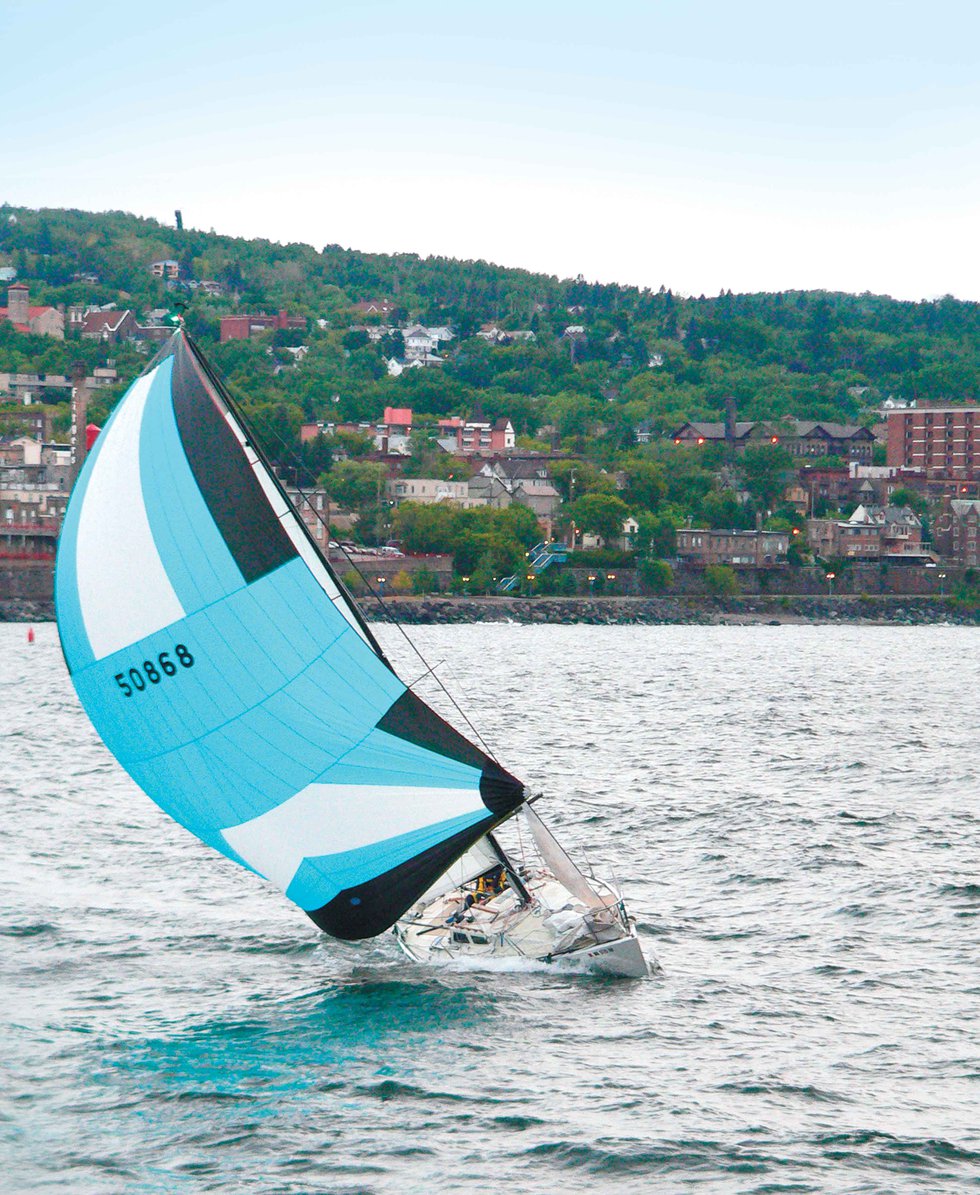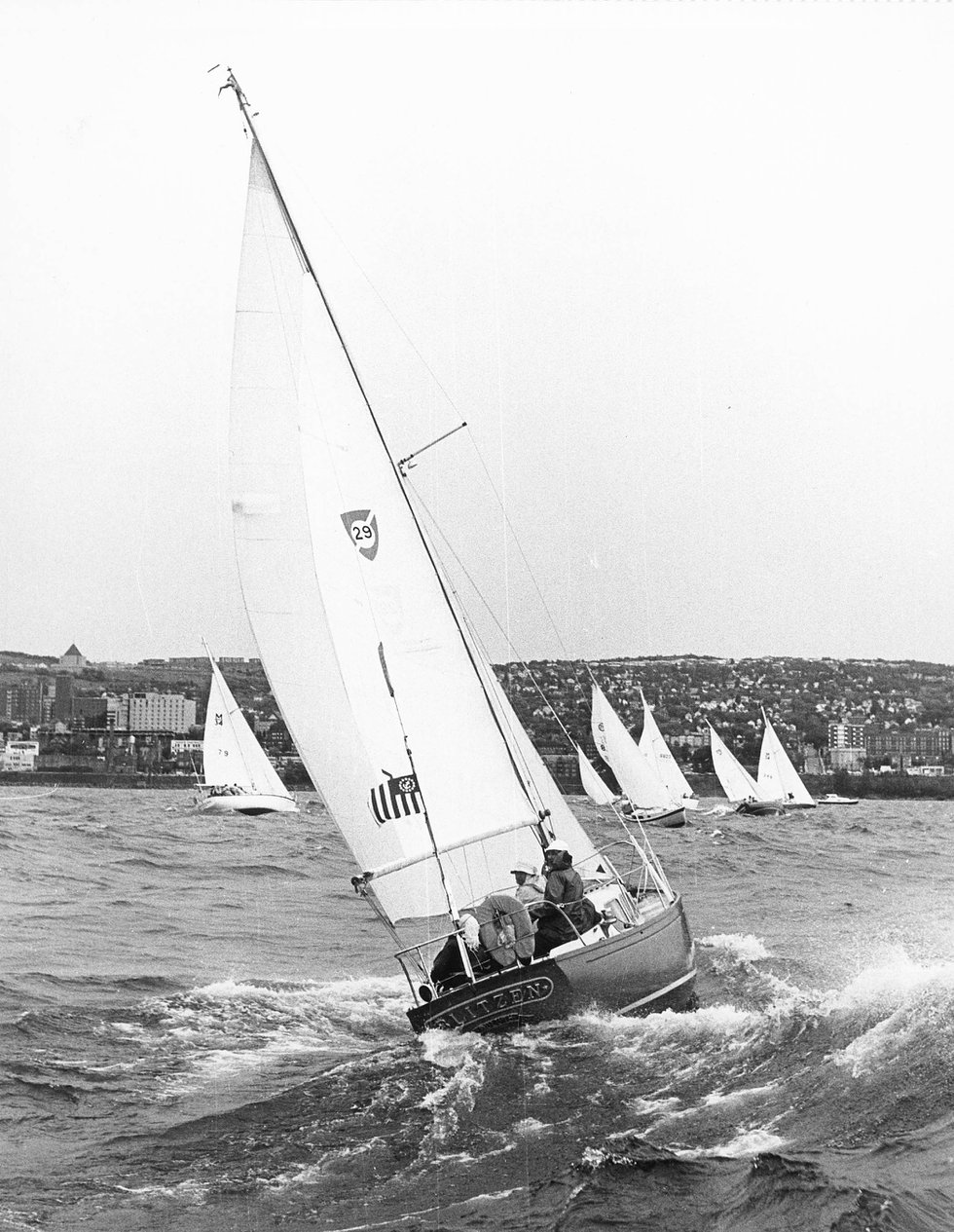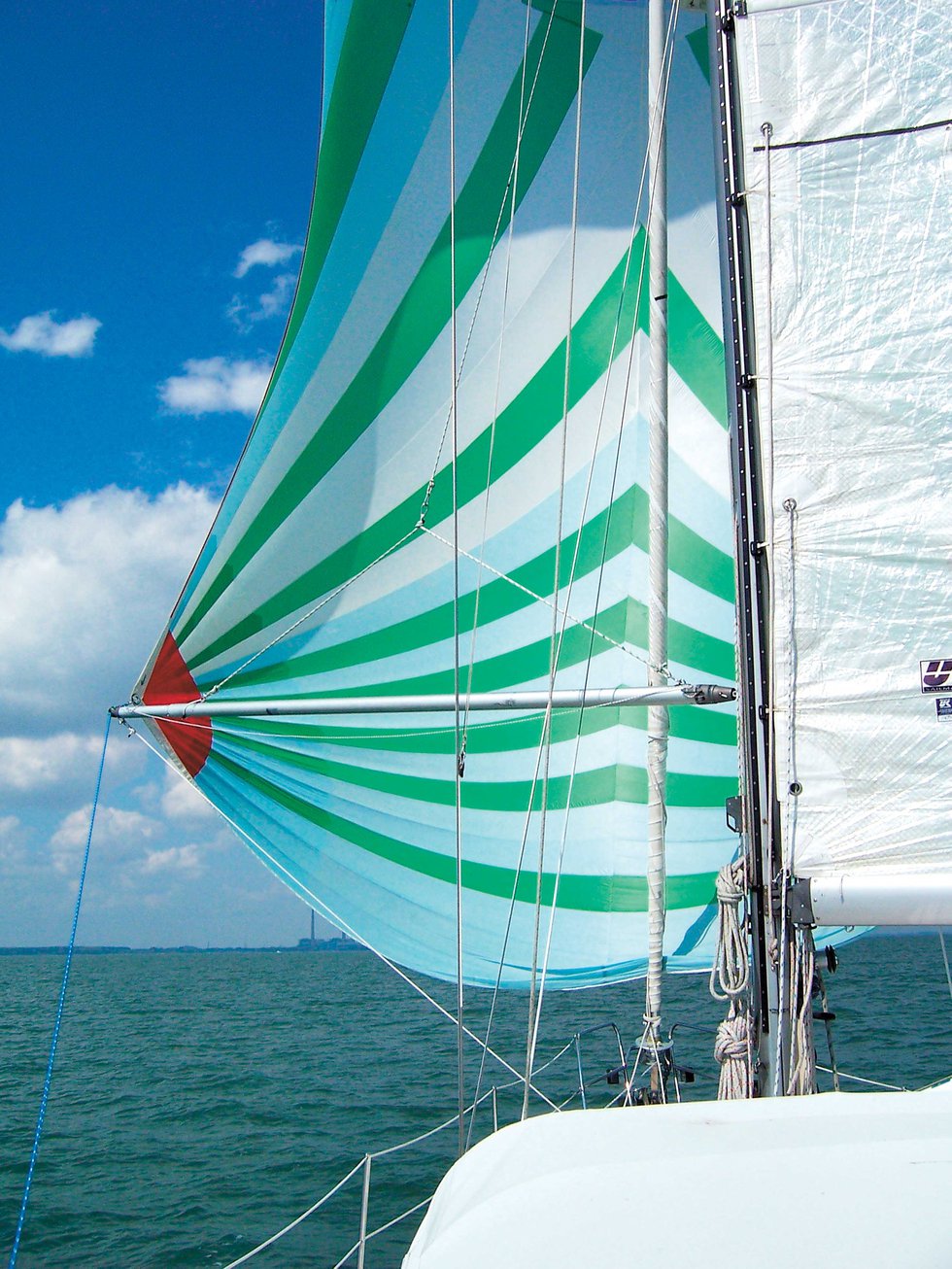
Wally McMinn / Great Lakes Singlehanded Society
Trans Superior Race
It’s all about the wind in your sails – and other good luck – for the Trans Superior racers. This photo, taken by Wally McMinn of the Great Lakes Singlehanded Society, represents a boat in the “singlehanded” class, sailboats crewed by a single person. This year will be only the third race that such a class has been entered.
In the end …
It was 2 a.m., just off of Two Harbors in a black night of heavy overcast, and Eric Thomas was alone on his 30-foot sailboat, Polar Bear, headed down Minnesota’s North Shore on the home stretch of the Trans Superior Race.
He’d spent the last couple of days with no more than 20 minutes of sleep at a time, and he was several hours from any real shut-eye.
Lightning began to flash from cloud to cloud above the hills. The sky got lighter and soon it was pink with lightning, bright as daylight.
A big storm was coming over those hills, Eric knew it. It was calm where he was, for the moment, and he had all his sail out. If he wanted to win this race, he needed to keep sails up until the last minute. He waited to see how fast the storm moved in.
Then his radio crackled; another sailor, John Ayres, farther offshore and a little behind, was calling. John had a lot of sophisticated weather equipment and the radio was talking about big winds and rain at a place called “Floodwood.” John wanted to know where that was.
Eric told him where to find the Minnesota town on his charts, and John told Eric about the storm and how it was traveling. Lightning slammed behind the hills.
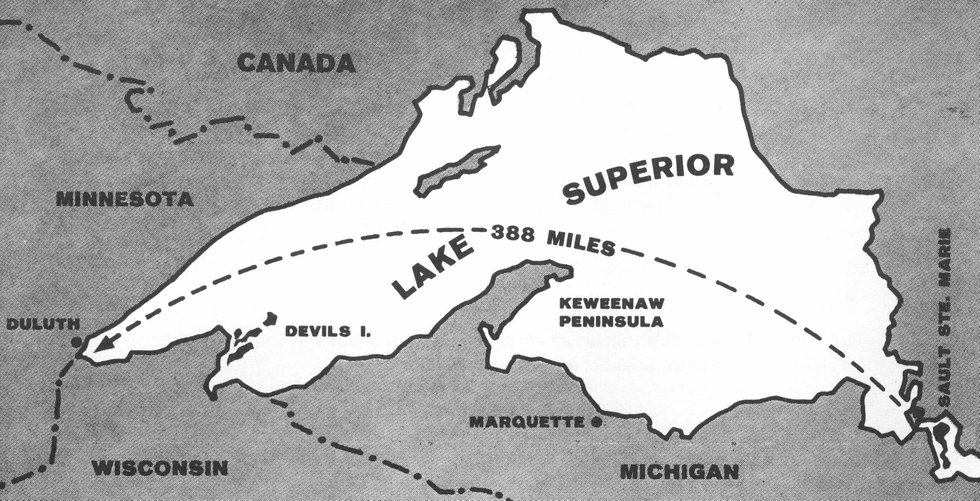
Trans Superior Race
Trans Superior Race
Such was the scene in 2005 near the end of the Trans Superior Race, run every odd year across Lake Superior and at nearly 390 miles one of the longest freshwater races.
Duluthian Eric Thomas knows the subtleties of long-distance racing. In 2008, he took second place in the Singlehanded TransPacific Yacht Race from San Francisco to Kauai, Hawaii – his first time in that race.
His family has raced since the 1970s. Eric remembers that as a 2-year-old, he would roll around on the cabin sole during races. This family crew has a distinctive style that serves Eric well on solo runs, too. “Our family, we’re not the best racers by any means, but we’re good at change. The more times things change, the more times you roll the dice, the better we do.”
Solo racing is like stepping backwards from the finish, step by step, Eric says. The fewer mistakes you make, the more likely you are to win. How you handle dubious gifts, like a storm, matters.
So Eric knew what to do that night in 2005 on his home surf of Lake Superior in his familiar Olson 30 sailboat.
“I said to Ayres, I’m going off the air. I’m going to disconnect electronics so they don’t get ruined. … I put on my survival suit, as much for insulation from a lightning strike as well as cold.”
Minutes before the 40-knot (46 mph) winds hit ahead of the storm, Eric took down his headsail and “double-reefed” the mainsail, folding it down smaller.
“Luckily I could steer 20 degrees off course. All the time, the boat planed (skimmed the water).”
In 45 minutes, Eric sailed 15 miles … mostly in the right direction. The storm “plastered John pretty good, but it propelled me up ahead. I ended up beating him by about an hour.”
Eric had been racing for 66 hours, 39 minutes nonstop.
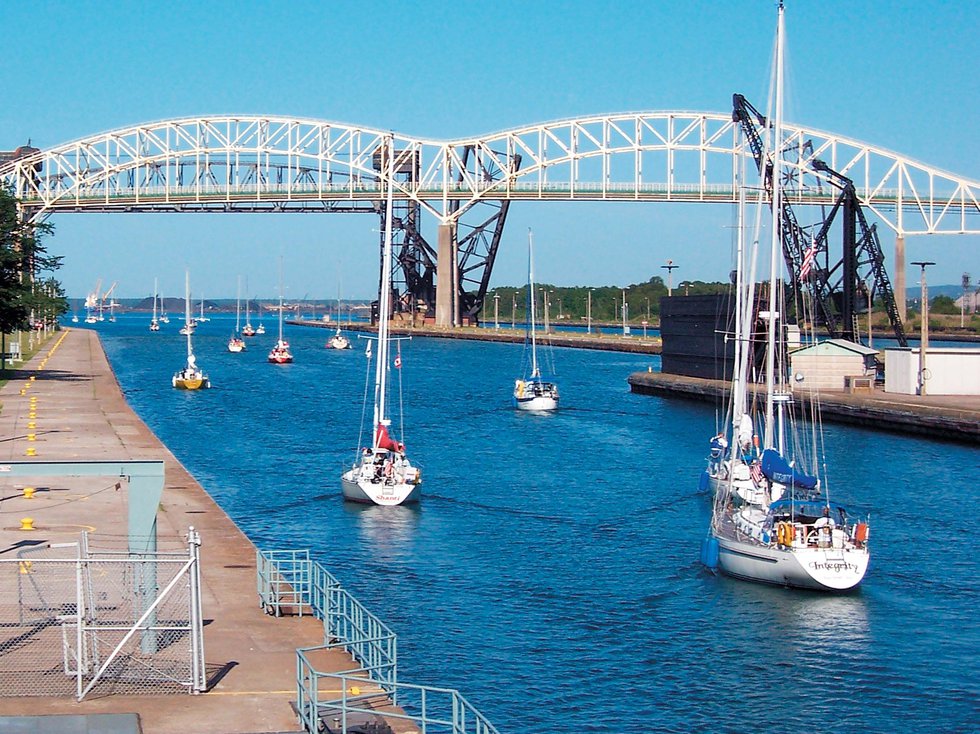
Wally McMinn / Great Lakes Singlehanded Society
Trans Superior Race
The Trans Superior Race starts in Sault Ste. Marie with the boats going under the International Bridge after being lowered 22 feet at the Soo Locks.
In the beginning …
Jack Soetebier lives on Park Point in Duluth, where out his windows he can see the great expanse of water that his boats, Blitzen and Hussar, traversed so many times. Jack is a founder of the Trans Superior Race along with John Pierpont, who docked his boat, Snark, at the Apostle Islands Marina in Wisconsin. John Pierpont died in March.
“It was really Dr. Pierpont’s brainchild,” says Jack, on a spring day when it seems possible that open water will return. We’re watching movies he made of the first race in 1969 – one of the family voyage to Sault Ste. Marie to start the race, one of the race itself, back to Duluth. There’s an indescribable Sixties charm in the films. Many heading to the Sault watched that year’s historic moon launch on TV at Whitefish Point, and there’s something of that explorers’ optimism in this little fleet of 22 boats, bobbing brightly on the screen in 8 mm film.
Jack recounts how it all began: John Pierpont wanted to sail in The Mac – a famous long-distance race from Chicago to Mackinac. But he needed yacht club backing to enter. So he and some friends started the Apostle Islands Yacht Club around 1960.
Then John thought it would be great to have a Sault-to-Duluth race, the longest freshwater race in the world at the time. He was tireless on the subject.
“He kept bringing it up at club meetings, and everyone just looked at him,” Jack says. “No one wanted to do it. It would be a big job, to get all the way to the Sault and then back against the prevailing winds.”
In the winter of 1968, Jack was in the front row at a yacht club meeting. “I owed him a favor. He had loaned me his 42-foot Siskiwit to sail for a couple of weeks up in Canada. I was out of a boat that year, and that’s, you know, like someone loaning you his wife . . . so I really owed him one.
“He was talking about the race again, and he saw me, and he said, ‘Jackson’ – he always called me Jackson – ‘let’s you and I race, and the rest can come along if they want. I want do it before I get too old to run it!’ And I felt like I had to do it then. He was about 56 and I was 42, so what do I say? I say, ‘Yes,’ and then the others fell in, too.”
Manley “Monnie” Goldfine, who died in April, began organizing the race. It was hosted that year and ever after by the Duluth Yacht Club, then called the Keel Club. Algoma Sailing Club in the Sault and the Thunder Bay Yacht Club also help now.
Bill Dunlop, fleet captain of the Thunder Bay club, has been in the race since 1989 and teaches sailing. He gives students four reasons to race: they’ll be better sailors; they’ll be able to handle a wide variety of conditions (races ignore most weather); they’ll learn attention to details; it’s fun. “When you finish your race, particularly a long race like the Trans Superior, there’s an amazing sense of accomplishment, regardless of how well you’ve done in the race.”
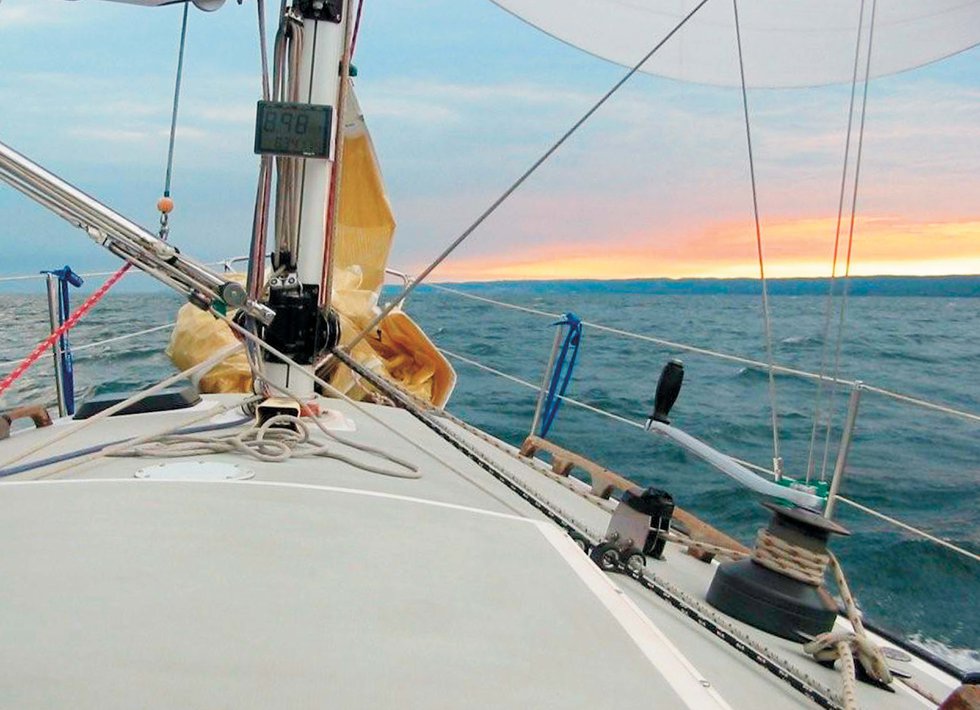
Keith Stauber
Trans Superior Race
Papa Gaucho, skippered by Keith Stauber, heads toward a sunset and a victory.
Permanent trophies for the overall winners and various class winners are housed at Sir Benedict’s Pub in Duluth, sitting on top of the beer cooler. Jack Arnold, former owner of the pub, has been a mainstay of sail racing in Duluth.
The boats are diverse, from as small as 24 feet to 40-plus feet, now mostly fiberglass, racing and cruising sailboats. They come from all the Great Lakes and the saltwater coasts.
The Trans Superior’s singlehanded or solo entries are a fast-growing division. In 2007, of 35 boats racing, 23 had solo sailors. But solo racing is new to the Trans. This year’s race is only the third time a solo division was part of the race. The crewed division is the heart of the tradition. They race hard all day and all night, shifting crews so that people get sleep.
This year, as always, the race starts off of Gros Cap in the mouth of the St. Marys River. Depending on conditions, boats should arrive in Duluth 40 hours to several days later. This year you can track the race from home, in real time. Every boat has a satellite transponder and the race website will follow progress.
There will likely be continued growth in the solo division and in a new category: boats with a crew of two. Time demands work against full crews – four to nine crew members; it takes up to a week just to get to the starting line in the Sault … and then the weeklong race begins. Finding half a dozen people who can all take off more than two weeks to sail is pretty hard nowadays. (Dr. Pierpont had a full crew of sons, but families that size are rare now.)
There remains a general dearth of women in the race, but boats have been crewed exclusively by women. Skipper Gail Bowdish in Shanti was the first solo female racer. Duluth skipper Keith Stauber’s winning Papa Gaucho has always had women on its crew, as do other boats. Keith says women are adept sailors, but spending days in close quarters means that the boat owner has to plan well for mixed crews.
Racers note that sail competition preserves traditional skills. Eric Thomas says that in the days when sailing ships had to get from Point A to Point B on a schedule, sailors handled whatever came up. Racing does much the same; you sail in all conditions, on a set course. Racing, these sailors say, teaches you what you and your boat can do. They love it for its challenges.
In the end, again …
Skipper strategy can win the Trans Superior, something that Duluth skipper Keith Stauber, sailing Papa Gaucho, understood when he took home top honors in the crewed division of the race in 2007.
Since 1977, Keith has raced the Trans Superior every time except two: one when a shoulder injury kept him out and one when he was racing in Russia.
“Sailboat racing has given me a lot of opportunities,” says Keith. “In 1985, I raced for two months in Florida with the America’s Cup helmsman Ed Baird.”
Keith used strategy and a bit of weather luck to win in 2007. His strategy involved using the Performance Handicap Rating Formula, or PHRF, to his advantage. What’s PHRF? Each type of boat has a record of racing performance used to assign it a handicap. Boats considered to have greater speed must “give time” – through handicaps – to inherently slower boats. As in horse racing, the goal is to make the race as close as possible. Thus, the first boat across the finish line may not win, depending on its “corrected time,” or the actual run time minus the handicap.
Papa Gaucho has a low handicap in the Duluth fleet, but in the “Trans,” where boats come from far away, many inherently faster boats have even lower handicaps and had to “give time” to Papa Gaucho.
So Keith’s strategy in 2007 was to sail a conservative race. “We knew they had to give us time, and the longer we stayed with them, the harder it would be for them to beat us on corrected time. So we stayed right with the pack; whatever they did, we did.”
The weather was nice in the beginning of the race, but during the second night the wind began to blow heavily out of the northwest. They were beating hard into it and had to change sails to reduce sail area.
Hours passed slowly; this isn’t pleasant sailing – heavy chop, night black as pitch, cold.
“We got tossed out of some waves. Then the boat almost stops, everything shakes and shudders, you can’t cook or eat. You just try to keep warm food in your crew,” says Keith. “It’s hard to be below without getting sick, but if you don’t eat and keep warm, you will get sick. You won’t have the body energy to fend it off.”
The wind had been pushing the fleet to the Ontario shore, but that was slowly changing. Everyone listened intently to weather reports. It was important not to tack – to change direction – too soon, but the boat that first caught the moment to head west would have the advantage.
“We put our best helmsman on. … Usually, even at night, there’s enough light to see the waves, but it was black, so dark you couldn’t see the waves at all. It was hard to steer over them. Finally I went below for a nap. Our strategy was to stick with the pack. I said, when I left the deck, that as soon as the first boat went west, to follow them.”
When Keith got back on deck, he saw two lights instead of the five or six once there. The deck crew thought a couple of boats had headed west. So Papa Gaucho immediately tacked, but the delay put them behind.
Things seemed bleak, but then, says Keith, “the wind gods brought the race home for us.” The wind picked up to about 25 knots (29 mph). The boat had been making 3 or 4 knots (3.5 to 4.5 mph), but with the new wind, it moved at 12 knots (about 13 mph) – very fast for a sailboat. Now all the boats were spread across the lake, and Papa Gaucho was pointed west, right at Duluth.
The lead boats had nearly reached port making 3 or 4 knots; Papa Gaucho skated the last 20 miles or so at 12 knots, closing the gap.
In the end, Keith and his crew spent 57 hours, 27 minutes sailing down the lake, but time gained by PHRF “corrected” that to 50 hours and 58 minutes.
Good strategy, good luck and a good wind gave them the overall prize.
Places to See Races
You can see sailboat races by the local yacht clubs. Check websites for details.
Thunder Bay Yacht Club: 6 p.m. Mondays and Fridays at the waterfront. www.tbyc.on.ca
Duluth Yacht Club: 5:15 p.m. Wednesdays at Canal Park. www.duluthkeelclub.com
Algoma Sailing Club (Sault Ste. Marie): 7 p.m Wednesdays on St. Marys River. www.algomasailingclub.org
Apostle Islands Yacht Club (Bayfield, Wisconsin): Special racing events. www.aiyc.net
The Trans Superior: Just the Facts
Race date 2017: 1 p.m. EDT, August 5
Race route: Sault Ste. Marie to Duluth (338 nautical miles or about 388 standard miles)
Fastest singlehanded time: 66 hours, 39 minutes, 14 seconds Polar Bear in 2007, Skipper Eric Thomas
Fastest overall crewed time ever: 28 hours, 38 minutes, Earth Voyager trimaran in 2001, Skipper Ray Howe
Website: www.transsuperior.com
Ann Klefstad is a sculptor, writer, and aspiring sailor who lives across the street from Lake Superior in Duluth.

